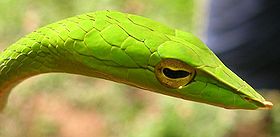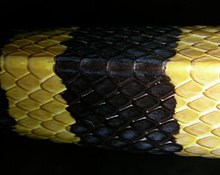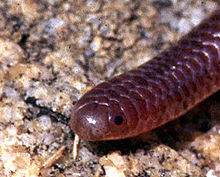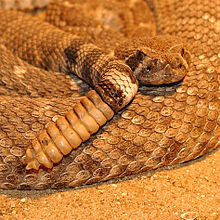Snake scaling

The snake scales or - pholidose the location and arrangement of the designated horny scales of snakes and their special features in construction. Snake scales are the body covering of snakes , the epidermis of which, like other reptiles, is covered by horn scales of various shapes and sizes. They protect the snake's body, prevent fluid loss, support locomotion, and change the body surface in terms of properties such as roughness to support camouflage.
The simple or complex colors and markings, which are important for camouflage and as a warning, can be traced back to the underlying skin color, the scales themselves are colorless or have a black pattern due to melanin deposits in the skin. The fold structure of the scaly skin makes it possible to hide conspicuous colorations between the scales and suddenly present them in order to deter predators.
In the course of evolution, the snake scales were also modified for other functions, for example as eyebrow "fringes" and as a protective cover for the eye. The strongest modification of the horn scales is the tail rattle of America's rattlesnakes . At regular intervals, snakes strip off their scales and form a new one. This molt allows damaged areas of the old skin to be replaced and helps remove ectoparasites . Above all, however, it allows the snake to grow, which would otherwise be hindered by the limited flexibility of the scales. The arrangement, structure and drawing of the scales are used as a taxonomic characteristic to determine the species and relationships.
Function of the scales

As with all reptiles, the snake skin and scales primarily serve as protection against evaporation and thus help to avoid dehydration. Due to the way the snakes move, the abdominal scales in particular have been heavily modified in order to reduce friction as the primary source of energy loss when moving. The ventral scales of the ground-dwelling species are correspondingly large and curved and thus have very little friction, while arboreal snakes can also use the edges of these scales as a grip on branches.
Furthermore, snakes register vibrations of the ground and the surrounding air and can differentiate between the two, using a complex system of internal resonance formations, in which the scales also play a role.
Morphology of the scales

Snake scales are formed by the underlying skin or epidermis. Each scale has an outer and an inner surface. The inner surface forms at the rear end a free area with which the following scale is overlapped, which protrudes accordingly from below.
A snake is born with a fixed number of scales. The number of scales does not increase with growth and maturity, nor does it decrease with time. However, the scales become larger and can change their shape with each new moult.
Around the mouth opening and on the sides of the body, snakes have smaller scales that allow the body to enlarge when eating, which allows the snake to swallow even very large prey.
Snake scales are made of keratin , the material that forms human hair and fingernails, for example. They are cool and dry.
Surface and shape
Snake scales come in very different shapes and sizes. They can be rough or have a smooth surface, and many have longitudinal keels or waves on the surface. Often snake scales have pits, tubercles and other fine structures that are visible either with the naked eye or only microscopically. They can be modified in shape and take on various shapes, such as eyebrow-like as is the case with the Usambara bush viper ( Atheris ceratophora ), or they form tail rattles like the American rattlesnakes.
Various original snakes such as the giant snakes (Boidae) and a number of very derived groups such as the vipers (Viperidae) have unevenly distributed, small scales, while other groups such as the snakes (Colubridae) and poisonous snakes (Elapidae) have large, symmetrically arranged scales the head, called shields.

Snake scales come in different forms, such as:
- round (cycloid) like blind snakes (Typhlopidae)
- long and with pointed ends like the nasal whip snake ( Ahaetulla nasuta )
- broad and leaf-like like the Asiatic pit vipers ( Trimeresurus spp.)
- square with approximately the same length and width as the banded rat snake ( Ptyas mucosa ).
- keeled to a greater or lesser extent as in the striped water snake ( Amphiesma stolatum ) or the sand rattle otter ( Echis ).
- with two-tooth tips
- lying next to each other like thorns like the plump sea snakes ( Lapemis ).
- large, non-overlapping nodules as in Xenodermis javanicus .
Another example of the modification of snake scales is the transparent scale that covers the snake's eye and is known as glasses . These glasses are often thought of as a fused eyelid. Like the other scales, it is renewed when it moults.
Tail rattle

The strongest modification of the snake scale is the tail rattle of the rattlesnake . This tail rattle consists of a series of loosely connected, interlocked chambers. When the rattle is shaken, the chambers vibrate against each other, generating the rattlesnake's warning signal. Only the base chamber is firmly attached to the tail.
A newborn rattlesnake only has a small chamber or "basal rattle" that is firmly attached to the tip of its tail. The first segment is added at the first moult. With each subsequent moult, another chamber is added until a rattle occurs. So the rattle grows as the snake ages, but the segments also break off easily; so the length of the rattle is not a reliable measure of the age of the snake.
colour
Dandruff consists mainly of solid beta keratins , which are basically transparent. With the exception of blue and green, the colors of the scales are created by pigments in the inner layers of the skin beneath the scales, not by the scale material itself. Blue is a structural color that is created by the structure of the scales. These scales diffract light and therefore appear blue. When this blue is combined with a yellowing of the underlying skin layer, the result is a bright green.
Some species of snakes can slowly change the color of their scales. For example, snakes often get lighter or darker as the seasons progress. In some cases this color change can also take place between day and night.
Molting

The shedding of the scales is known as ecdysis, or molting . In snakes, the outer layer of skin is completely shed. Snake scales do not stand individually, but are formations of the skin. They are therefore not skinned individually, but shed as a cohesive, outer layer of skin with each skinning, similar to a stocking turned inside out.
The molt serves several purposes: firstly, the old and worn skin is replaced, secondly, ectoparasites such as ticks or mites are removed, and thirdly, the molting is also a prerequisite for further growth.

The molt occurs at regular intervals in the life of a snake. Before molting, the snake stops feeding and often looks for a safe shelter. Shortly before the moult, the skin becomes cloudy and dry, and the scales (glasses) covering the eye also become whitish or bluish cloudy. The inner surface of the old skin layer liquefies, so that the old skin separates from the new one. After a few days the eyes will clear again. The old skin breaks open at the mouth and the snake wriggles out of the old skin, often rubbing against rough surfaces. Often the old skin peels off in one piece from head to tail, like an old stocking. The newly formed, larger and lighter skin underneath comes to the fore. The shed snake skin or exuvia is also known as the "adder shirt".
An older snake usually only sheds its skin once or twice a year; however, a fast growing young snake up to four times a year. The shed skin provides a perfect image of the scales and can be used to identify species if well preserved.
Arrangement of the scales
Except at the head, the scales overlap like the tiles on a roof. Snakes have rows of scales over their entire length. Especially on the head, but also on other parts of the body, there are also many specialized scales that are present individually or in pairs.
The dorsal or back scales are arranged in rows along the entire length of the body. Adjacent rows are offset diagonally from one another. The number of rows of scales is greatest in the middle of the body and decreases towards the front and back. In some aquatic and marine species, the scales are rounded. The rows of these species cannot therefore be counted.
Scale names
The different scales of the head and body of the snake are shown below using photographs of the Striped Water Snake ( Amphiesma stolata ), a snake that is common in South Asia.
Head shields
The naming of the head shields usually begins with the reference to the nostrils, which are easy to identify on the snake. There are two shields that contain the nostrils, appropriately referred to as the scuta nasalia or just the nasalia. The outer nasal (towards the tip of the snout) is the prenasal, the inner (towards the eye) the post nasal. The scales on the top of the snout that touch the nasals are called internasalia.
Between the two praenasalia there is a single shield on the tip of the snout called the Scutum rostrale or simply rostrale .
The scales around the eyes are known as the circumorbitalia or scuta ocularia . A special feature here is the transparent scale that covers the eye and is known as an eyepiece scale or glasses. The circumorbitalia in front of the eye (from the tip of the snout) are called praeocularia, those behind the eye are called postocularia. Above the eyes are the supraocularia, which in many snakes consist of a single plate and can be formed into structures such as horns or the like (for example in the African horned vipers ( Cerastes )). The scales at the bottom of the eyes are called the subocularia.
The lorealia can be found between the praeocularia and the postnasalia . The scales that make up the upper and lower lips are the labialia, with the scales of the upper lip being called the supralabials and the scales of the lower lip being called the sublabials or infralabials.
On the top of the head between the eyes and adjacent to the supralabials are the frontalia , in front of it are the praefrontalia up to the tip of the snout and the internasalia with which they are in contact. On the back of the head behind the eyes and following the frontals, the parietals adjoin , below are the temporals .
On the underside of the head, the snake has a front scale called the mental scutum or mentale , which faces the rostral. These are followed by the sub- or infralabialia. Below the head is a pair of front chin shields and behind them a pair of rear chin shields. The gularia lie between the rear chin shields in the throat area , behind which the abdominal scales or ventralia begin . The mental pit is a pit below the head that is centrally located between the chin shields and the gularia.
Body dandruff
The scales that cover the body are called the dorsalia or costalia. Sometimes there is a series of enlarged scales on the center of the back along the spine, called the vertebrals . The enlarged scales on the abdomen are the ventralia or gastrointestinal webs.
In many derived snakes ( Caenophidia ), the ventralia are connected to the vertebral bodies of the spine, which allows the number of vertebrae to be determined without vivisection by counting the shields.
Tail scales
At the end of the ventralia there is an often divided anal plate ( scutum anale ) that surrounds the cloaca . The part of the body behind this anal is called the tail of the snake.
Often snakes have enlarged shields on the underside of their tails, which can be single or in pairs. These are the subcaudalia or urostructures. They can be smooth or keeled. The end of the tail usually tapers to a simple tail tip, as is the case with most snakes. However, it can also form a thorn as in the Australian death adder ( Acanthophis ) or a bony spur as in the bushmaster ( Lachesis muta ). In the rattlesnakes it forms the tail rattle that has already been treated, and in the sea snakes it forms a flattened oar tail.
Terminology of the scales

Legend
| ag - Anterior chin shields f - Frontals in - Internasals l - Loreale la - Supralabialia la ' - Sublabialia m - Mental n - Nasalia p - Parietalia | pf - Praefrontalia pg - Posterior chin shields pro - Praeoculare pso - Praesuboculare pto - Postocularia r - Rostrale so - Supraoculare t - Anterior and posterior temporalia v - First ventral |
The terminology of dandruff, in particular, can vary greatly depending on the species and group. This is mainly due to the different head signs in the various taxa . This list contains the most common terms:
- Dandruff
- Trunk scales
-
Tail scales
- Anal
- Subcaudale , urostan
-
Further common technical terms
- Canthus rostralis , also abbreviated as Canthus
- Mental pit
Importance for the taxonomy
Scale features do not play an essential role in distinguishing families , but they do play a role in differentiating at the level of genera and species. Therefore there is a specific nomenclature for the scales of the snakes. The structure and surface of the scales, their arrangement and color, as well as the division of the anal scales (anals), in combination with other morphological characteristics, are the essential features for systematically classifying snakes at species level.
In certain regions of North America with a relatively small number of species, easily understandable identification keys have been developed on the basis of a simple identification of scales, which should also enable laypeople to differentiate between poisonous and non-poisonous species. In other regions with a high diversity of snakes, such as in Burma , such a distinction is not possible without a careful examination of the respective snake.
To study scale characteristics, it is necessary to catch a snake and carefully examine the head and body in the hand. The high-resolution digital cameras available today, however, make it possible to precisely examine the scaling and thus often to identify them without catching them, given the correct perspective.
The scaling can also be used for individual identification in field studies. The shortening of certain scales is often used to mark individuals in order to estimate the size of a population in the context of catch-recapture experiments.
Cultural meaning
Snakes are a motif in human culture and religion around the world and a fascinating and frightening object. The lively drawing of the scales, such as the Gaboon viper , fascinates the human mind and at the same time frightens it. Such drawings have inspired fear or worship since prehistoric times, as can be seen in the art of that time. Studies of the fear and excitement of images suggest that scaling is an essential component of our image of snakes. Snake scales also seem to have influenced Islamic art, as certain mosaic surfaces show great resemblance to scale drawings of snakes.
Snakeskin has an aesthetic value due to its often very regular cross or net drawings and was therefore used for the manufacture of many articles from leather, also for the manufacture of fashion accessories. However, the use of snake skins has put many snake populations at risk. This resulted in international restrictions on trade in certain species or populations ( Washington Convention on the Protection of Species ). In many countries today, animal rights activists are promoting the use of artificial snakeskin made from printed leather, patterned artificial fabrics, plastics or other materials.
Evidence cited
- ^ The Center for Reptile and Amphibian Conservation and Management, Indiana: The Snakes of Indiana . online ( Memento from April 19, 2012 in the Internet Archive ). Accessed July 19, 2008.
- ^ Peter H. Hartline: Physiological Basis for Detection of Sound and Vibration in Snakes. In: Journal of Experimental Biology. 54, 1971, pp. 349-371 ( abstract ).
- ↑ Harry W. Greene: Snakes - The Evolution of Mystery in Nature. University of California Press, Berkeley 1997, ISBN 0-520-20014-4 , p. 22.
- ↑ a b c Chris Mattison: Rattlers! A natural history of rattlesnakes. Blandford, London 1996, ISBN 0-7137-2534-6 , pp. 23-27.
- ^ North Carolina State Wildlife Damage Notes - Snakes ( January 15, 2015 memento on the Internet Archive ), North Carolina State University. Accessed July 19, 2008.
- ^ Pennsylvania State University - Wildlife Damage Control 15 (PDF; 196 kB)
- ^ AE Leviton, GOU Wogan et al .: The Dangerously Venomous Snakes of Myanmar, Illustrated Checklist with Keys. In: Proceedings of the California Academy of Sciences. 54 (24), 2003, pp. 407-462.
- ^ A b c Eckart Voland, Karl Grammer: Evolutionary Aesthetics. Springer Verlag, 2003, ISBN 3-540-43670-7 , pp. 108-116.
- ^ The Endangered Species Handbook - Trade (chapter) Reptile Trade - Snakes and Lizards (section) ( Memento of March 6, 2006 in the Internet Archive ). Accessed July 19, 2008.
literature
- George A. Boulenger: The Fauna of British India including Ceylon and Burma, Reptilia and Batrachia . Taylor and Francis, London 1880.
- JC Daniels: Book of Indian Reptiles and Amphibians . BNHS. Oxford University Press, Mumbai 2002.
- W. Harry: Greene: Snakes - The Evolution of Mystery in Nature . In: University of California Press. 2004, pp. 22-23 (excerpted from Google Book Search beta on August 7, 2006).
- AE Leviton, GOU Wogan et al: The Dangerously Venomous Snakes of Myanmar, Illustrated Checklist with Keys. In: Proceedings of the California Academy of Sciences. 54, No. 24, 2004, pp. 407-462.
- David Mallow, David Ludwig, Göran Nilson: True Vipers. Natural History and Toxicology of Old World Vipers. Krieger Publishing Company, Malabar (Florida) 2003.
- Malcolm A. Smith: The Fauna of British India, Ceylon and Burma including the whole of the Indo-Chinese Sub-region. Reptilia and Amphibia. Vol I - Loricata and Testudines, Vol II-Sauria, Vol III-Serpentes. Taylor and Francis, London 1943.


